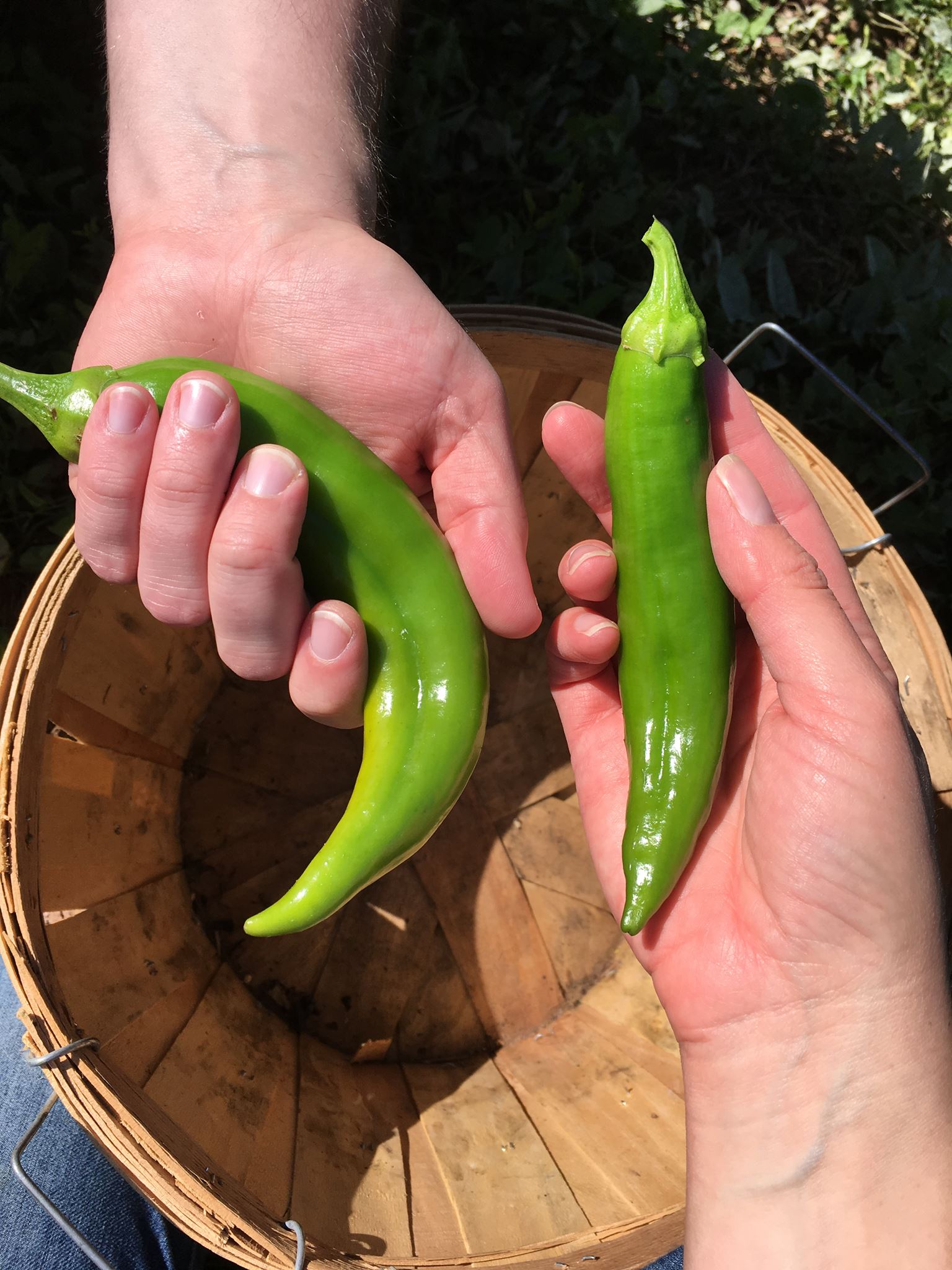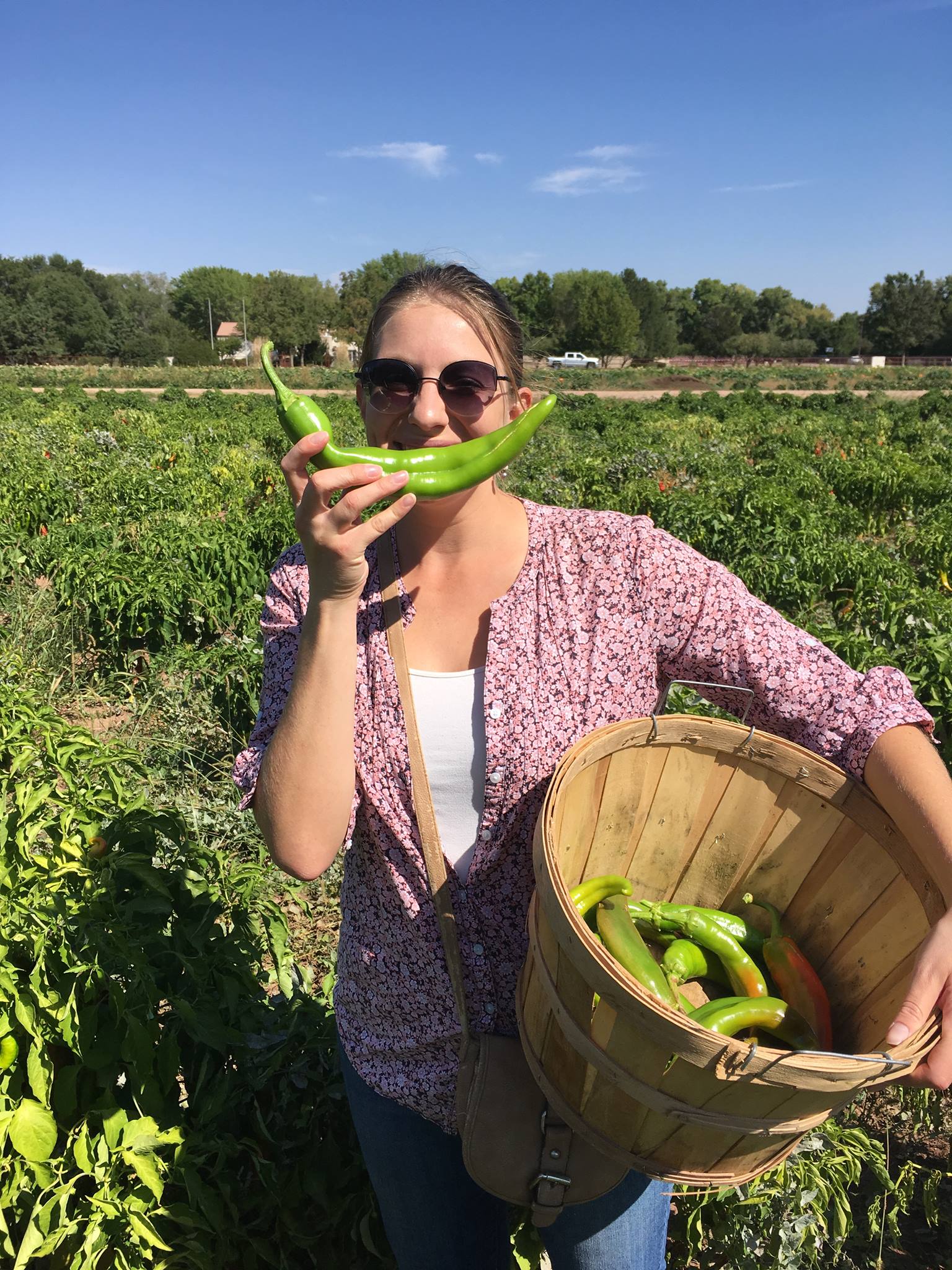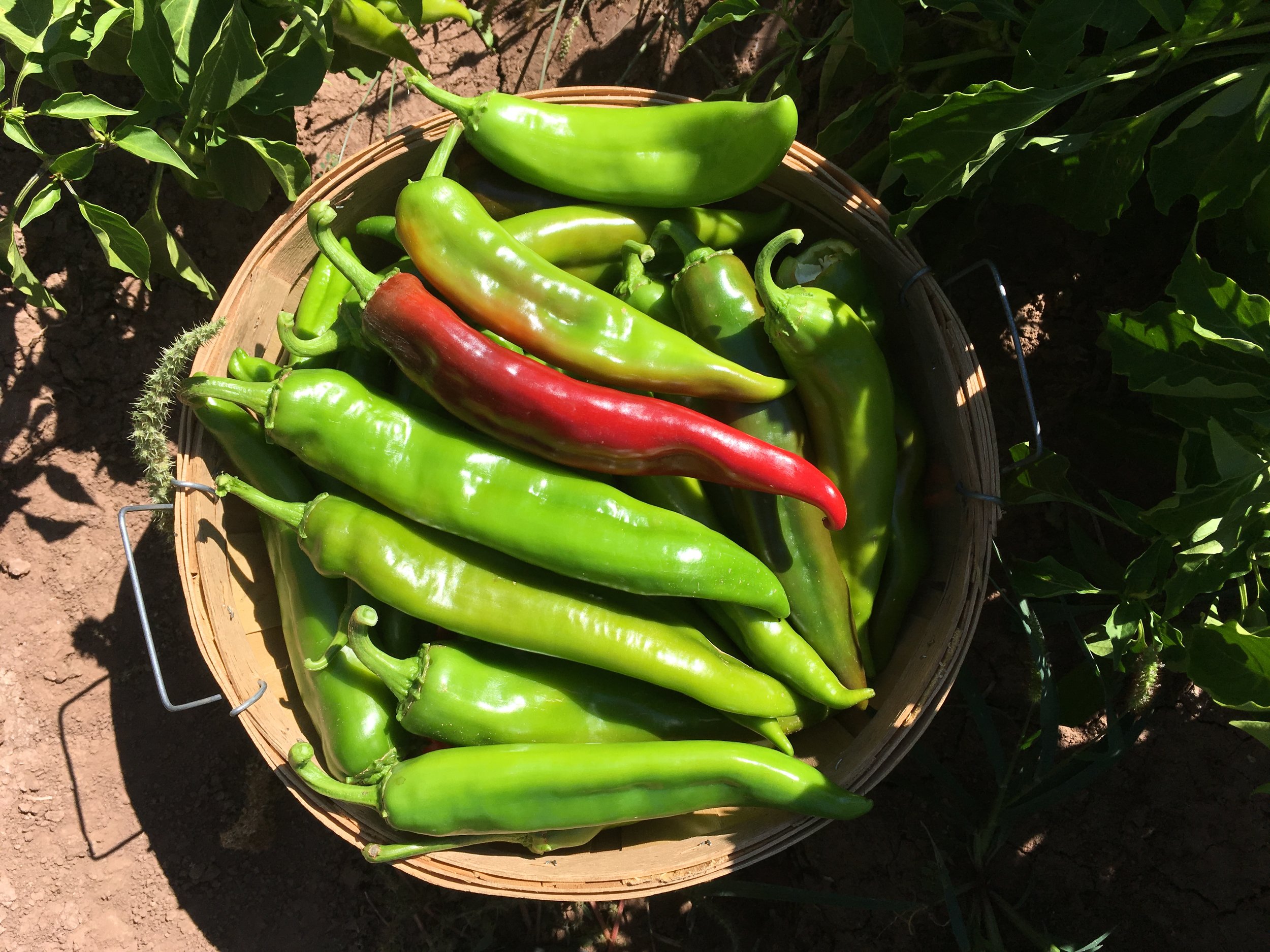We not only harvested our own chile peppers yesterday, we had them roasted right there on the farm thanks to this friendly gentleman!
Pick /
Given the choice between quick, easy, fake experiences and ones where you’ve got to sweat a little, I pick the latter. Specifically, today we’re picking chile peppers on a farm just north of Albuquerque. The sun is warm, the light almost blinding; the ground is both soft and rough underfoot. The air is cool and breezy and smells green, steamy with vegetation. We have to kneel and reach to find pods between leaves. Some are already nibbled by mysterious creatures of the night. Some have gone pulpy and liquid from insects or other blights. It’s up to us to feel our way to the firm, glossy peppers that will fill our half-bushel basket and eventually our stomachs.
Sure, a morning of U-pick on a farm is a bit fake too. The experience was constructed for us to play at a little light agriculture as paying tourists. But still: the rich earth, the plants rooted in it, the dangling peppers—the knowledge that we’re harvesting real food and will later taste the fruits of our labor and be sustained by them—that’s still a thick vein of authenticity coursing with lifeblood from the ground into our bodies. I’ll take it.
Existential /
Travel is a beautiful thing. Experiencing a place in person captivates us in a way screens and text never can. It can fill a deep craving within each of us: for connection, immersion, wonder, and awe.
In an age of (sub)urban isolation and digital identities and super-convenient fast food, that craving is deeper and thirstier than ever. It’s so powerful that entrepreneurs are trying to capitalize on it by charging admission to pop-up experiences in trendy cities:
I’ve spent the past few months going to as many temporary “experiences” as I could find in New York, to explore every broadly themed “mansion” and “factory” and “museum” possible before they all shutter and reconvert into the empty storefronts of high-rent blight. […]
By classifying these places as experiences, their creators seem to imply that something happens there. But what? Most human experiences don’t have to announce themselves as such. They just do what they do. A film tells a story. A museum facilitates meaning between the viewer and a work of art. Even a basic carnival ride produces pleasing physical sensations.
The central experience delivered at all these places is one of waiting. […] What are we waiting for? Places that are themselves reminiscent of lines. At 29Rooms, a pop-up from the women’s site Refinery29, I waited outside big white tents to get into makeshift rooms like “Star Matter,” a space curated in collaboration with Nicole Richie, which features big fake rocks, little fake stars and a hanging red orb. The aesthetic recalls the line for Disneyland’s Splash Mountain, except in here, Fleetwood Mac was playing. One of the features of the Rosé Mansion is a fake gold throne that you can sit on while wearing a fake gold crown, an event akin to hanging out in the lobby of the New Jersey Medieval Times. Each of these experiences culminates in a ball pit — filled with “marshmallows” at Candytopia, “champagne bubbles” at the Rosé Mansion, and blue-colored balls at Color Factory — a feature pioneered by the McDonald’s PlayPlace.
Yet these line-adjacent experiences are pitched as somehow transformative. In a plaque outside the “Star Matter” room, the experience was teased as “a cosmic pilgrimage of love, music, and connectedness into the California night sky and back in time to the 1970s, a decade defined by progressive group thinking.” The Color Factory says it’s designed to “invite curiosity, discovery and play.” The Museum of Ice Cream’s Pint Shop is said to “inspire and empower audiences to be their most creative selves.” Mostly, we’re expected to have the time of our lives. A Candytopia employee announced: “The first rule is to be happy and always smile! Frowns make other people sad!”
Compare the significance of traveling for hours out into the wilderness to touch and smell an authentic place in the world, like a fragrant forest or ancient cliff dwellings, versus the “existential void” conjured by attempts to quickly construct semi-nonsensical themed experiences in a rented space. One is a pilgrimage into others’ slowly-woven stories that expands our sense of the many interconnected ways that human communities have lived over the centuries. The other is a commercialized series of surfaces against which to pose briefly for a photo. One strengthens our connection to each other and our sense of self within a species. The other encourages us to flash fake smiles while diving more deeply into our own lonely narcissism.
Experience /
There’s nothing quite like being in a place, physically engulfed, saturating your every sense with its essence. Photos and descriptions don’t compare. They can add up to an intellectual recognition, but not a full-body understanding of this bodily life.
Cliffs /
The morning after camping: a hike among the Gila Cliff Dwellings to glimpse how people slept, worked, gathered, and ate some eight hundred years ago.
For thousands of years, groups of nomadic people used the caves of the Gila River as temporary shelter. In the late 1200's, people of the Mogollon Culture decided it would be a good place to call home. They built rooms, crafted pottery and raised children in the cliff dwellings for about twenty years. Then the Mogollon moved on, leaving the walls for us as a glimpse into the past.
Camping /
Camping is a fairly artificial construct, at least the way we do it: drive to a designated campground, keep our fires confined to a pre-constructed fire ring, pitch a store-bought tent and zip ourselves in from the chill of the night. Still, it’s a night spent with our backs on the cold hard dirt, miles from any electricity or traffic, our ears hearing only birds and deer and our eyes adjusted only to starlight. It’s something. And it’s how we slept (or tried to sleep) out in the Gila National Forest this week.
Wilderness /
Wilderness. The word itself is music.
Wilderness, wilderness… We scarcely know what we mean by the term, though the sound of it draws all whose nerves and emotions have not yet been irreparable stunned, deadened, numbed by the caterwauling of commerce, the sweating scramble for profit and domination.
Why such allure in the very word? What does it really mean? Can wilderness by defined in the words of government officialdom as simply “A minimum of not less than 5000 contiguous acres of roadless area”? This much may be essential in attempting a definition but it is not sufficient; something more is involved.
Suppose we say that wilderness invokes nostalgia, a justified not merely sentimental nostalgia for the lost America our forefathers knew. The word suggests the past and the unknown, the womb of the earth from which we all emerged. It means something lost and something still present, something remote and at the same time intimate, something buried in our blood and nerves, something beyond us and without limit. Romance—but not to be dismissed on that account. The romantic view, while not the whole of truth, is a necessary part of the whole truth.
But the love of wilderness is more than a hunger for what is always beyond reach; it is also an expression of loyalty to the earth with bore us and sustains us, the only home we shall ever know, the only paradise we ever need—if only we had the eyes to see.
Edward Abbey
Desert Solitaire: A Season in the Wilderness
(pp 166-7)
Autumn /
…and just like that, it’s autumn.
Equinox /
Experienced at Albuquerque’s Open Space Visitor’s Center this evening: A fiery sunset. A silvery moonrise. The precise moment of equinox across the globe.
Peace /
Happy International Day of Peace!
The International Day of Peace ("Peace Day") is observed around the world each year on 21 September. Established in 1981 by unanimous United Nations resolution, Peace Day provides a globally shared date for all humanity to commit to Peace above all differences and to contribute to building a Culture of Peace.
2018 Peace Day Theme:
This year's #peacedaycelebrates the 70th anniversary of the Universal Declaration of Human Rights: "The Right to Peace- The Universal Declaration of Human Rights at 70." Learn more here:
#standup4humanrights














